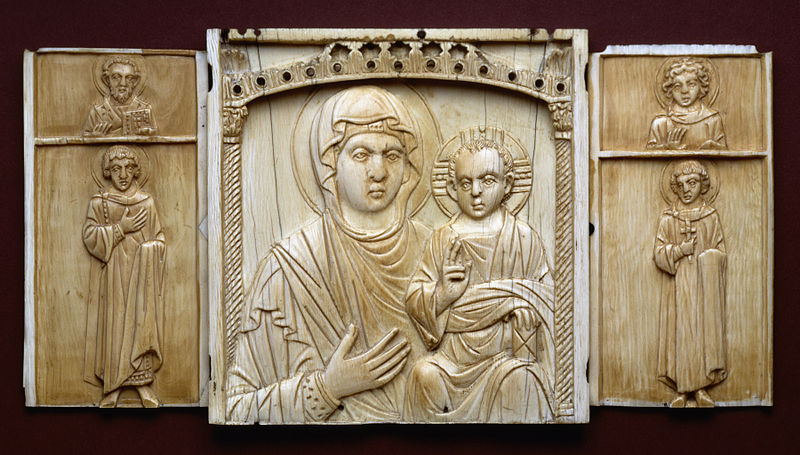The ivory icon from Fortress Rusocastro
The icon was discovered durig archaeological survey in 2017 at Rusocastro Fortress. In essence, it is an ivory tile measuring 8.05 cm in height; the length is 2,8 cm and the thickness is 0.71 cm. The tile is double-sided embossed. Shallow vertical cracks are present on its surface, which means that a tuft of more than 8 cm in diameter is used, ie the center of the tuft is used. Two margins are formed on the face of the tile. Above is a full-length image of Archangel Gabriel and St. Basil the Great, Bishop of Caesarea at the bottom. The back of the tile is also divided into two fields. The upper one depicts a "bloomed cross" and the lower one shows a "Calvary cross."


The images are extremely masterfully executed, in high relief. The archangel is in profile on the left. The right leg is moved forward and steps the whole step, and the left leg is resting only on the fingers, emphasizing the movement. He is dressed in a richly draped chiton. With one hand holding a rod with spheres, the other is raised in a gesture of blessing.
St. Basil is represented beltedly. A large cross was placed over his shoulder. With his left hand he holds a richly decorated book with fasteners. The face is presented with extraordinary details - two-parted beard, mustache, large nose, even the pupils of the eyes.
The only, partly similar find in Bulgaria, was discovered in the distant 1901 during the excavations of the royal citadel of Trapezitsa in Veliko Turnovo. It is part of an ivory icon representing the Annunciation scene. The Rusokastro icon is much better preserved as a complete artifact.
The icon from Rusokastro also points, at first glance, to a similar scene. Clearly, this icon is a diptych or triptych wing. However, there is a serious possibility, based on such preserved findings, that this may be the right wing of the triptych. The central panel should be with the image of the Holy Virgin and the left side with the image of St. Michael the Archangel and possibly St. John Chrysostom.
The Rusokastro icon may have been a metal fitting - gold or silver hanging around his neck. If this assumption is true, then the icon was probably owned by the highest representative of the church clergy in Byzantium.
The icon from Rusokastro was made in the middle of the 10th century in Constantinople, in one of the imperial studios for such production. Ivory items are known to be ordered only by the emperor and his closest circle of faces. This is because ivory was extremely expensive. It is not by chance that when supplies of this raw material were already stopped in the XI century, an alternative but much cheaper raw material of steatite began to be used.

The closest parallels to the icon of Rusokastro in size and image are today stored in the British Museum and the Walters Museum of Art in Baltimore, USA (see image above).
The Rusokastro icon is a world-class find. Today, such artifacts are only stored in the largest museums in the Western world and in several church treasures belonging to Catholic cathedrals in Western Europe. They were brought there by knights from the Fourth Crusade, who, by plundering the Byzantine imperial treasury, donated such extremely valuable relics to Christian temples in their native places.
Author: PhD Milen Nikolov


